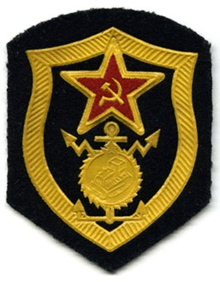Tallinn Higher Military-Political Construction School
The Tallinn Higher Military-Political Construction School (Russian: Таллинское высшее военно-политическое строительное училище, ТВВПСУ; Estonian: Tallinna Kõrgem Ehitusvägede Poliitiline Sõjakool, TKEPS) was one of the military academies of the Soviet Union. In the years it existed, it trained military personnel in a number of specializations. It was located in Tallinn, which was the capital of the former Estonian SSR.
Таллинское высшее военно-политическое строительное училище Tallinna Kõrgem Ehitusvägede Poliitiline Sõjakool | |
 Patch of the academy | |
| Type | military academy |
|---|---|
| Active | 18 August 1979–28 April 1992 |
| Founder | Soviet Government |
| Affiliation | |
| Students | 1,800 |
| Location | , |
History
It was created by the Council of Ministers of the USSR of on 18 August 1979. It was formed in on the basis of the 64th course of the political staff of the Land Forces.[1] On 30 October 1980, the Tallinn Military-Political Building School was awarded the Battle Flag.[2] The first graduation of cadets place in 1984. On 28 April 1992, TVVPSU produced ahead of schedule the last graduation of 255 officers. Along with the military profession, they received the qualification of "social educator". Until the end of May 1992, about 700 cadets were transferred to other military schools in Russia.
Transfer of the Military School to the Estonian Authorities
Jägala training center, located outside of Tallinn, was part of the school. It was handed over by Soviet/Russian forces to the Kalevi Battalion of Estonian Defence forces in 1992. This transfer was also the first peaceful take-over done by the Estonian Armed Forces. Former masters were given 3 days to move out and take their clothing and food supplies with them.[3] The Estonian authorities refused to appeal to TVVPSU command with requests for permission to export property and equipment to Russia. But despite the difficulties, valuable property was managed to be taken out by air and transferred to other military schools, part of the property and the universal computing complex were transferred to the Russian Embassy in Estonia, the rest to military units deployed in Tallinn, which came under the jurisdiction of the Russian Armed Forces. In early June 1992, the Battle Banner of the school was deposited at the Central Museum of the Armed Forces, the dissolution of the university was completed on April 25, 1993.
Activities
School structure
- Leadership
- Head of the school
- Deputy head of the school
- Training department
- Political department
- Human Resources
- Combat department
- Finance department
- RAV service
- Services of ware and food supply, fuels and lubricants
- Housing and operational department
- Automotive service
Studies
- Tactics and military disciplines
- Foreign languages
- History of the Communist Party of the Soviet Union
- Military pedagogy and psychology
- Organization (in the field of economics, technology and military construction)
- Philosophy
- Political Economics
- Engineering design
- Military buildings and special structures
- Scientific communism
- Physical training and sports
- Military technical disciplines
Support and service units
- Military Band
- Educational Training Battalion
- Medical Service
- Technical Laboratory
List of leaders
Heads of the School
- Vasily Gnezdilov (1979-1987)[4]
- Yevgeny Aunapu (1987-1991)
- Boris Bachin (1991-1992)
Deputy heads of the school
- Dmitry Ostrolutsky (1980—1982)
- Valery Vishnevsky (1982—1991)
- Sergey Porshnev (1991—1992)
Notable graduates

- Alar Laneman – Estonian Brigadier General and member of the 14th Riigikogu.[5]
- Andres Valme – Editor-in-chief of the newspaper "Golden Province"[6]
- Mikhail Porechenkov – Russian film actor, producer, director who became famous after playing as FSB Agent Alexey Nikolayev in the TV series National Security Agent (1999–2005).[7]
- Igor Panchuk – Officer in the Russian Armed Forces.[8]
See also
References
- "Таллиннское высшее военно-политическое строительное (ТВВПСУ) было сформировано в апреле 1980 года на базе 64-х курсов политсостава Сухопутных войск".
- "30 октября 1980 года начальник политического управления военно-строительных частей Минобороны СССР генерал-полковник В.И. Быченко вручил училищу Боевое Знамя. After the fall of the USSR, the Estonian Government tried to expel the cadets of the school. 28 апреля 1992 года ТВВПСУ досрочно произвело последний выпуск 255 офицеров. Наряду с военной профессией они получили квалификацию «социальный педагог». До конца мая 1992 года около 700 курсантов были переведены в другие военные училища в России. Эстонская сторона не раз предпринимала попытки силой захватить училищное имущество, вооружение, технику и казарменно-жилищный фонд. Например, 21 июня 1992 года эстонская военизированная организация «Кайтсейлит» совершила вооружённое нападение на училищный учебный центр Ягала. Эстонские власти отвечали отказами на обращения командования ТВВПСУ с просьбами дать разрешение на вывоз имущества и техники в Россию. Но вопреки трудностям ценное имущество удалось вывезти воздушным транспортом и передать в другие военные училища, часть имущества и универсальный вычислительный комплекс были переданы посольству России в Эстонии, оставшаяся часть — дислоцировавшимся в Таллинне воинским частям, перешедшим под юрисдикцию Российской Федерации. В начале июня 1992 года Боевое Знамя училища было сдано на хранение в Центральный музей Вооружённых сил, расформирование вуза завершено 25 апреля 1993 года".
- https://www.postimees.ee/2512745/mida-kirjutas-postimees-5-aastat-tagasi-olumpialaste-nimed-teada-jagala-sojavaelinnak-voeti-ule
- https://docplayer.ru/54378354-Tallinskoe-vysshee-voenno-politicheskoe-stroitelnoe-uchilishche.html
- https://www.ekre.ee/team/alar-laneman/
- http://www.labyrinth.ru/content/card.asp?cardid=46262
- https://uznayvse.ru/znamenitosti/biografiya-mihail-porechenkov.html
- https://web.archive.org/web/20150402003426/http://315vsp.ru/index/0-23